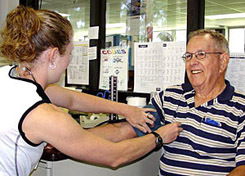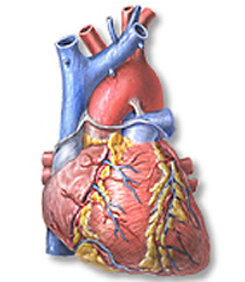
September is National Cholesterol Education Month, a good time to get your blood cholesterol checked and take steps to lower it if it is high.
National Cholesterol Education Month is also a good time to learn about lipid profiles and about food and lifestyle choices that help you reach personal cholesterol goals.
High blood cholesterol affects over 65 million Americans. It is a serious condition that increases your risk for heart disease; the higher your cholesterol level, the greater the risk. You can have high cholesterol and not know it. Lowering cholesterol levels that are too high lessens your risk for developing heart disease and reduces the chance of having a heart attack or dying of heart disease.
The National Heart, Lung, and Blood Institute offers helpful resources to use during National Cholesterol Education Month.
What is Cholesterol
Also called: HDL, Hypercholesterolemia, Hyperlipidemia, Hyperlipoproteinemia, LDL
Cholesterol is a waxy, fat-like substance that occurs naturally in all parts of the body. Your body needs some cholesterol to work properly. But if you have too much in your blood, it can stick to the walls of your arteries. This is called plaque. Plaque can narrow your arteries or even block them.
Why Is Cholesterol Important?
Your blood cholesterol level has a lot to do with your chances of getting heart disease. High blood cholesterol is one of the major risk factors for heart disease. A risk factor is a condition that increases your chance of getting a disease. In fact, the higher your blood cholesterol level, the greater your risk for developing heart disease or having a heart attack. Heart disease is the number one killer of women and men in the United States. Each year, more than a million Americans have heart attacks, and about a half million people die from heart disease.
How Does Cholesterol Cause Heart Disease?

When there is too much cholesterol in your blood, it builds up in the walls of your arteries. Over time, this buildup causes "hardening of the arteries" so that arteries become narrowed and blood flow to the heart is slowed down or blocked. The blood carries oxygen to the heart, and if enough blood and oxygen cannot reach your heart, you may suffer chest pain. If the blood supply to a portion of the heart is completely cut off by a blockage, the result is a heart attack.
High blood cholesterol itself does not cause symptoms, so many people are unaware that their cholesterol level is too high. It is important to find out what your cholesterol numbers are because lowering cholesterol levels that are too high lessens the risk for developing heart disease and reduces the chance of a heart attack or dying of heart disease, even if you already have it. Cholesterol lowering is important for everyone--younger, middle age, and older adults; women and men; and people with or without heart disease.
What Do Your Cholesterol Numbers Mean?
Everyone age 20 and older should have their cholesterol measured at least once every 5 years. It is best to have a blood test called a "lipoprotein profile" to find out your cholesterol numbers. This blood test is done after a 9- to 12-hour fast and gives information about your:
-
Total cholesterol
- LDL (bad) cholesterol--the main source of cholesterol buildup and blockage in the arteries
- HDL (good) cholesterol--helps keep cholesterol from building up in the arteries
- Triglycerides--another form of fat in your blood
If it is not possible to get a lipoprotein profile done, knowing your total cholesterol and HDL cholesterol can give you a general idea about your cholesterol levels. If your total cholesterol is 200 mg/dL* or more or if your HDL is less than 40 mg/dL, you will need to have a lipoprotein profile done. See how your cholesterol numbers compare to the tables below.
| Total Cholesterol Level | Category |
|---|---|
| Less than 200 mg/dL | Desirable |
| 200-239 mg/dL | Borderline High |
| 240 mg/dL and above | High |
* Cholesterol levels are measured in milligrams (mg) of cholesterol per deciliter (dL) of blood.
| LDL Cholesterol Level | LDL-Cholesterol Category |
|---|---|
| Less than 100 mg/dL | Optimal |
| 100-129 mg/dL | Near optimal/above optimal |
| 130-159 mg/dL | Borderline high |
| 160-189 mg/dL | High |
| 190 mg/dL and above | Very high |
HDL (good) cholesterol protects against heart disease, so for HDL, higher numbers are better. A level less than 40 mg/dL is low and is considered a major risk factor because it increases your risk for developing heart disease. HDL levels of 60 mg/dL or more help to lower your risk for heart disease.
Triglycerides can also raise heart disease risk. Levels that are borderline high (150-199 mg/dL) or high (200 mg/dL or more) may need treatment in some people.
Educating Your Neighbors about Cholesterol
Many of your neighbors may benefit from a better understanding of cholesterol – it might even save their lives! The National Cholesterol Education Month in September is an excellent opportunity to organize a cholesterol educational event for your community.
If an organized event is not reasonable, consider creating an educational display for your health center, community center, pool, club house, park, or wherever your neighbors congregate.
Neighborhood Link suggests the teaching tools below from the National Heart, Lung, and Blood Institute
These resources are produced by the U.S. Department of Health and Human Services and are therefore not bound by typical copyright laws and can be legally reprinted and used in your efforts to educate your neighbors.
For Table and Bulletin Board Displays
This booklet is a "must read." It offers lots of practical advice for steps you can take to reach a lower cholesterol and to improve your lipid profile.

Tables and Text from Your Guide to Lowering Your Cholesterol with Therapeutic Lifestyle Changes (TLC)
- What's Your Heart Disease Risk? - p. 8
- What's Your 10-Year Risk for a Heart Attack? - pp. 10-12
- Drop Your Cholesterol with TLC - p. 16
- Setting Your LDL Goal - p. 9
- The TLC Diet: A Heart Healthy Eating Plan - p.19
- Sample Saturated Fat Intakes - p. 22
- Fiber Solutions - p. 28
- Fiber Really Counts - p. 29
- How to Make Heart Healthy Meals - pp. 39-40
- Losing Weight and Gaining Heart Health - pp. 49-50
- How to Lower Your Calories on TLC - p. 50
- Choose the Foods That Help You Lose - pp. 51-52
- A Handy Guide to Calories Burned in Common Activities - p. 46
- Benefits of Regular Physical Activity - p. 42
- Getting Active - p. 44
Heart Healthy Recipes
- Keep the Beat: Heart Healthy Recipes
- Heart Healthy Home Cooking African American Style
- Delicious Heart Healthy Latino Recipes
 Print
Print Email
Email







